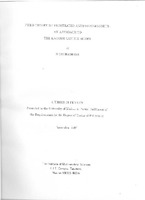- DSpace Home
- →
- IMSc Theses/ Dissertations
- →
- IMSc Theses/ Dissertations
- →
- View Item
JavaScript is disabled for your browser. Some features of this site may not work without it.
| dc.contributor.author | Shubashree, D. | |
| dc.date.accessioned | 2009-08-18T06:23:40Z | |
| dc.date.available | 2009-08-18T06:23:40Z | |
| dc.date.issued | 2009-08-18T06:23:40Z | |
| dc.date.submitted | 1997 | |
| dc.identifier.uri | https://dspace.imsc.res.in/xmlui/handle/123456789/77 | |
| dc.description.abstract | Low lattice dimensionality and frustration are producing interesting effects in quantum antiferromagnets. The aspect of frustrated Heisenberg antiferromagnets has been the motivating factor of much work done in this field. This thesis studies the ground states and low lying excited states of some models exhibiting the features in magnetic systems with novel order. In the 1-D Spin-chain, due to low dimensionality fluctuations destroy the Neel order and the ground state is a spin singlet. In two dimensions, in the nearest neighbour Heisenberg antiferromagnet on a square lattice there is a strong tendency of fluctuations to drive the system to disorder. In spin wave theory the ordered moment is reduced by about 40% indicating the tendency of the strong quantum fluctuations to drive the system into a disordered phase. In the case of nearest neighbour Heisenberg antiferromagnet on the triangular lattice, the ground state spin configuration of the classical model is deformed into the 120 degree planar spiral. In this thesis the triangular antiferromagnets(TLAF) is analysed in depth by semiclassical approaches, numerical and exact diagonalization studies etc., The Kagome Lattice antiferromagnetic model (KLAF) is a system with geometry similar to TLAF, but with a lower coordination number of 4. Various problems associated with this model are discussed in this thesis. It is found that in the TLAF, the number of lowest lying states is finite and the energy gap is found to increase linearly with S(S+1) thereby forming a pisa tower of states which is a signature of the symmetry broken ground state. Whereas in KLAF, there is a rapid proliferation of low lying states which do not form the pisa tower. Among the different competing candidates groundstates of the KLAF, it is felt that the approach to the KLAF, starting from another ground state, for instance the 'q=0' could also open up very interesting in this context. | en_US |
| dc.subject | Quantum Effect | en_US |
| dc.subject | Triangular Lattice AntiFerromagnet | en_US |
| dc.subject | Kagome Lattice Model | en_US |
| dc.title | Field theory of frustrated antiferromagnets; An approach to the Kagome Lattice Model | en_US |
| dc.type.degree | Ph.D | en_US |
| dc.type.institution | University of Madras | en_US |
| dc.description.advisor | Shankar, R. | |
| dc.description.pages | v; 95p. | en_US |
| dc.type.mainsub | Physics | en_US |
Files in this item
This item appears in the following Collection(s)
-
IMSc Theses/ Dissertations
IMSc Theses/ Dissertations
